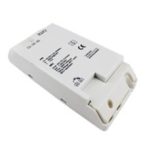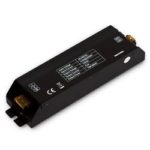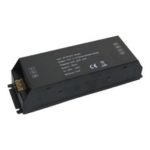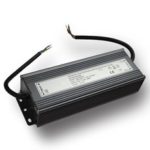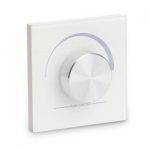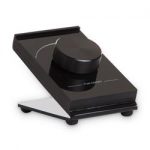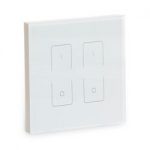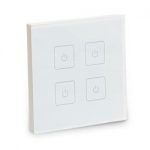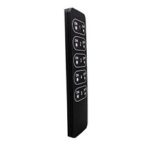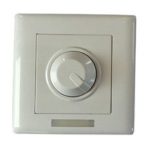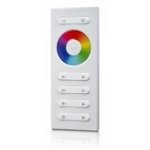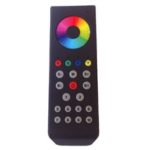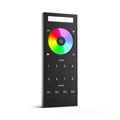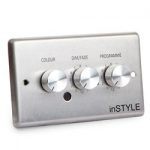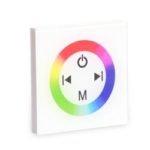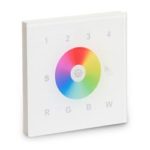Dimming – how to control white and single-colour LED strip lights
If you’re looking for advice on dimmable LED lights, this page will explain some of the most effective methods you can use.
What methods can I use to dim my LED tape? Which LED dimmers should I choose?
There are several methods you can use for LED tape dimming. Each has its advantages, there is no ‘best’ way to control dimmable LED tape. The right choice for you depends on the kind of project you’re installing.
The best and most cost-effective dimming method for your project depends on two main factors:
How big is your project?
If you have a small project that uses just one transformer, you don’t need dimmable LED lights that can manage multiple zones. (Such as DALI drivers, 0-10v dimmer modules or DMX LED strip controllers). Instead, you’ll be best served by a simple mains-dimmable transformer, or an inline or RF LED dimmer.
But for bigger projects (dozens of dimmable LED tape strips, for example, each with their own transformer), you will need LED dimmers with more flexibility – like a DALI, 0-10v or DMX 512 system.
-
What kind of dimmer interface do you want?
Your preferred type of LED dimmer control unit is a vital factor when choosing how to manage your dimmable strip lights. If you want a fancy wireless touchscreen dimmer, for example, then you can immediately ignore all wired LED dimmers.
At InStyle LED, we have a wide selection of interfaces for your dimmable LED lights. You can choose from wireless wall units and remotes, wired wall-mounted touch panels, hand-held controllers, and single-zone or multizone LED dimmers.
So in summary:
- For small projects: choose RF controllers / TRIAC (mains-dimmable) transformers / inline LED dimmers
- For large projects: choose 0-10v / DMX / DALI
What is TRIAC dimming?
TRIAC (‘TRIode for Alternating Current’) dimming – also known as mains dimming or phase dimming – is a simple way to manage your dimmable LED lights. At InStyle LED we supply a range of mains dimmer transformers, available in 30w, 75w or 150w versions.
You can then simply connect its input to many standard household mains dimmer switches. (Use InStyle’s own TRIAC wall dimmer/remote pack, or alternatively we recommend Aurora’s AU-DSP400X dimmer module and Varilight’s V-Pro series.)
With this very straightforward setup, you will be able to smoothly dim your lights from your LED dimmer control. You can choose any style and finish of dimmer switch – rotary or touchpad, wired or remote. You can even connect multiple transformers to a single mains dimmer switch.
What is 0-10V dimming?
A 0-10V lighting control system works by varying the DC voltage supplied to your LEDs – between zero volts (‘off’) and ten volts (100% brightness). These LED dimmer controls are a very popular choice for hotels, restaurants and similar installations.
Once you’ve wired an appropriate 0-10V dimming receiver in between your dimmable LED lights and your transformer, you’ll be able to connect multiple 0-10V dimming receivers together. As many as your installation needs. Your final LED dimming receiver can then be wired to any 0-10V dimmer control unit.
InStyle LED don’t supply 0-10V LED dimmer control units, but we do stock the 0-10V dimmer receivers that you need.
FYI… 0-10V light control is sometimes also known as ‘1-10V’ (usually in the context of fluorescents).
What is DALI dimming?
The DALI (‘digital addressable lighting interface’) dimming protocol was originally developed as a successor to 0-10V systems. LED control systems of this type are best suited to big installations. For example, projects that need a control system to manage dimmable LED lights across a whole building from one central DALI dimmer switch.
DALI dimming systems are often used in hotels, offices, large stores – and by homeowners creating a special place to live. DALI systems typically give the user control across the entire installation, and let you override general settings with smaller LED dimmers in each room or zone.
When installing a DALI system, your DALI dimming receiver should be wired in between your dimmable LED lights and transformer. As soon as it’s in place, you can connect all your DALI receivers together using signal cable, and link them to your DALI dimmer switch.
What is DMX dimming?
DMX LED controls can manage up to 512 channels (the protocol’s full name is ‘DMX 512’). The channels for each DMX LED strip receiver are set by DIP switches on the side of the unit, using 9 binary switches. With these switches, you can set every channel up to 512.
Simply enter the DMX channel you need (0 – 511), and the calculator will show you the corresponding DIP switch combination.
Even 10 years ago, home users wouldn’t have heard of DMX LED strip control, as the available controllers were all big expensive DMX desks built for the theatre and entertainment industry. But these days, DMX controllers can be funky touch screen panels or rotary dimmers. They can even run on your computer or smartphone. Depending on your needs, controlling your dimmable LED lights using DMX can be as simple or as complex as you wish.
DMX LED strip control systems can be easily used in your home, or in restaurants, clubs, hotels and most other locations.
DMX LED strip example 1:
For a home installation, you could simply fit a touchscreen dimmer or RGB controller. You would then wire a transformer to your DMX receiver, and wire the receiver to your dimmable LED tape. Finally, connect the receiver to your DMX LED strip controller with signal cable.
One great advantage offered by the DMX protocol is the ability to link together as many DMX receivers as you wish. Then they can all be managed through one controller, giving you fully synchronised control.
DMX LED strip example 2:
For larger projects, you’ll probably choose different LED controls – perhaps a computer-based interface. This will give you more functionality. You can set up each DMX LED strip receiver to be controlled individually. (This could be each area of a restaurant, or each room in a hotel). Once the system is installed, you’ll be able to preset times for your lights to come on and their, or even programme them to flash or pulse.
The control given by a DALI system is almost limitless – whether you want to dim to different levels in different parts of your restaurant, or control hundreds of strobing disco lights in a club or on a stage.
What is RF dimming?
RF (‘radio frequency’) LED dimming lets you set and adjust your strip lights wirelessly. The dimming controller sends a radio signal that can manage one or more dimming receivers, up to a range of 20m. We typically recommend RF dimming for use in the home, and for small projects such as restaurants or single-room installations.
An attractive feature of RF dimming is its wide range of controller options. You can choose from handheld remote LED dimmers, single-zone dimmers and multizone dimmers, wall controllers and many others.
Single-zone RF dimmers explained:
Even though it can’t manage multiple zones and settings, there’s no practical limit to the amount of LED tape you can control with a single-zone dimmer. This is because you can connect multiple RF receivers (as many as you need) to one RF dimmer – so all your linked LED strip lights will be dimmed together. This means you can wirelessly connect areas that can’t be linked via wired connections, and control them all through just one LED dimmer.
With a multizone RF controller, you’ll have the option to manage different lighting areas independently of each other. (Different areas are sometimes called ‘zones’ or ‘channels’.) For example, you could set your dimmer’s first zone to manage your kitchen’s under-cabinet lights, and its second zone to control the plinth lighting at the base of your breakfast bar – all through just one multizone RF dimmer.
This is a great solution for setting different light levels in parts of larger rooms, or in hotels, restaurants, clubs or bars.
What are Inline LED dimmers?
As the name implies, inline LED dimmers are wired in between the transformer and its LED strip lights. These dimmers are best for use in very small installations – as inline dimming doesn’t allow you to link multiple dimmers together. (So you can’t manage multiple LED strips through a single controller.)
At Instyle LED, we offer two kinds of inline dimmer:
Either of these LED controls is a good low-cost option. Both are reliable, and very easy to wire and connect. The inline keypad dimmer is ideal for samples, or for setting your LED light to the level you want and then leaving it.
Can I use an app to dim my LED tape from my iPhone/Android phone?
Yes. You’ll need one of our wifi adaptors, linked to a compatible dimming receiver.
The EasyLighting app is very easy to use, even if you’re using it to control multiple lighting zones / areas. EasyLighting works for whites, single-colour and RGB colour-changing LEDs. So you can have a mix of different lighting installations in your home and control all of them through your phone. You can even add hardware such as wall controllers or other remote controls, giving you a choice of ways to adjust your LEDs if you don’t want use your phone all the time. (These work through RF, so you’ll still have control if your wifi is down.)
EasyLighting is available for Android and Apple devices – you can download here (Android) or here (Apple), and see our instructions for use here.
What is the difference between a zone and a channel? And between single-zone and multizone?
When we’re talking about lighting control, ‘zone’ and ‘channel’ both mean the same thing. Both terms describe the idea of lights linked together, which can be then managed via a single control – in one zone, one channel, one block or one area.
What is the difference between a LED controller and a LED dimmer?
You may have heard the terms ‘controller’ and ‘dimmer’ being used about LED lighting systems, by be puzzled by the difference between them. In simple terms, they’re both talking about the same thing. Both let you manage the settings and light levels of your LED tape installation.
At InStyle LED, we like to keep things clear and straightforward for our customers. That’s why we use the term ‘LED dimmer’ to describe our control units for white or single-colour LED tapes. These units allow you to switch your LED strip lights on/off, and adjust their brightness levels up or down.
For control units designed to manage our RGB (colour-changing) LED tapes, we use the term ‘LED controller’. These offer more functions than single-colour dimmers. They can set up colour-scrolls, time delays, strobing, colour mixing and a variety of other options. LED controllers can also dim your RGB lights in addition to their other functions, of course.
Why do some LEDs flicker when being dimmed?
LED bulbs from some manufacturers are marked as non-dimmable; these may flicker if they are used with some dimmers. Such bulbs may also flicker if the dimmer does not meet the bulb’s minimum load.
Why do LEDs flicker on video but not in reality?
Even though our LED strips and dimmers give you smooth dimming with no flicker visible to the human eye, you may still see some flickering in some of our videos. Why is this?
This misleading effect is the result of pulse width modulation (PWM). LED dimmers adjust the brightness of their linked LED tape by using PWM – which means the LEDs all switch on/off thousands of times each second. The more the light is dimmed, the more time the LEDs spend ‘dark’. This switching is far too quick to be seen by the human eye, but may be picked up by a video camera.
Constant-voltage LED drivers for high-end applications
For this kind of specialist project, InStyle can supply a range of constant-voltage LED drivers. These transformers (available in 12V / 24V models, all DMX and DALI compatible) can be dynamically programmed up to 65kHz – enabling users to dim the constant voltage fixtures for unprecedented accuracy for dimming & colour control.
If you’re planning a project like this, why not give us a call?
Will dimming my LED tape reduce the tape’s lifetime?
No it won’t. You could permanently set your LEDs to a dimmed level and it wouldn’t affect their operational life expectancy. (If anything, running your LEDs at less than 100% will actually extend their life, as there will be less heat output.)
Is all LED tape dimmable?
However…
LED strip lights are dimmable only if wired to a suitable dimmable transformer or controller. If you dim LED strips that have been wired to a non-dimmable transformer, you’ll damage the transformer. For the different ways you can dim your LED tape, see the notes above. You can use any of these methods with any of our single-colour or white LED tapes. For our RGB LED strip lights, you will require an RGB controller (or controllers).
Do RGB LED tapes need different dimmers to white / single-colour LED tapes?
RGB controllers offer not only full LED dimming, but also colour-scrolls, fades and many other settings. This is because there are more options available when mixing three light colours.
Does my mains-dimmable transformer need a special LED dimmer?
No it doesn’t. InStyle LED’s mains-dimmable transformers (also called TRIAC dimmable transformers) will work with most standard rotary dimmer switches, to offer smooth dimming all the way from 0-100%.
You will need to make sure that your transformer’s total wattage isn’t greater than the total wattage of your LED dimmer. For example, some types of rotary LED dimmers handle a maximum wattage of 300w, 400w, 600w or 1000w. If you have four 150-watt transformers, then you will need to use a 600w dimmer rather than a 400w one.
I have heard of control systems such as Lutron, Rako, HDL and Control 4. What are they, and are they compatible with your LED tapes?
Systems like Lutron, Rako, HDL and Control 4 are advanced home-control systems. With them, you can manage a variety of functions around your home. As well as controlling your dimmable LED lights, they can close blinds and adjust your heating thermostat at preset times, for example.
If you want complete control of your home (setting different lighting levels, programming times, switching the whole house off automatically when you leave etc) at the touch of a button, touchscreen or your iPad, then one of these systems is exactly what you need.
For projects in London and the surrounding area, our Lutron control-system specialist can offer practical advice on Lutron systems of all types, for commercial premises and large homes.
What sizes of mains-dimmable LED transformer do you offer?
We offer four types of mains-dimmable LED transformer:
What LED dimmers do you offer?
InStyle’s range includes a variety of LED dimmers. We offer the following (click on each picture for more information):
What RGB LED controllers do you offer?
InStyle’s range includes a variety of RGB LED controllers. We offer the following (click on each picture for more information):
